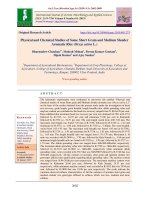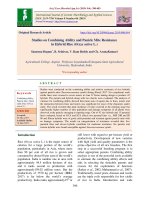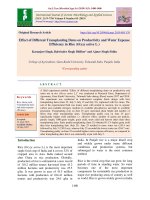Evaluation of different weed management practices and crop geometry on weed control efficiency and yield of direct (Dry) seeded rice (Oryza sativa L.)
Bạn đang xem bản rút gọn của tài liệu. Xem và tải ngay bản đầy đủ của tài liệu tại đây (183.81 KB, 7 trang )
Int.J.Curr.Microbiol.App.Sci (2020) 9(8): 3354-3360
International Journal of Current Microbiology and Applied Sciences
ISSN: 2319-7706 Volume 9 Number 8 (2020)
Journal homepage:
Original Research Article
/>
Evaluation of Different Weed Management Practices and Crop
Geometry on Weed Control Efficiency and Yield of Direct (Dry)
Seeded Rice (Oryza sativa L.)
Vasundhara Kaushik*, S. P. Singh and Sirazuddin
Department of Agronomy, G. B. Pant University of Agriculture and Technology,
Pantnagar, Uttarakhand, Pin code- 263145, India
*Corresponding author
ABSTRACT
Keywords
Direct seeded rice,
Grain yield,
Herbicides, Row
spacing, Weed
management
practices
Article Info
Accepted:
26 July 2020
Available Online:
10 August 2020
A field experiment was conducted during Kharif season of 2017 in D2 block at
Norman E. Borlaug Crop Research Centre of G. B. Pant University of Agriculture
and Technology, Pantnagar intending to find out the efficacy of different pre and
post -emergence herbicides for controlling the weeds and also their effect on direct
(dry) seeded rice in three planting geometries. The maximum weed control
efficiency 96.59, 72.81, and 82.32 percent was obtained at a row spacing of 25 cm
with the pre- and post- emergence application of pendimethalin 1kg /ha fb
penoxsulam 22.5 g/ha at 40, 60 and 80 DAS. Row spacing of 25 cm recorded the
highest grain yield (4.2 t/ha) which was comparable to 20 cm row spacing and
significantly superior to 30 cm row spacing. Application of pendimethalin 1 kg/ha
fb penoxsulam 22.5 g/ha recorded highest grain yield (4.4 t/ha) after weed free.
Highest B:C ratio (2.0) was obtained with 25cm spacing along with the preemergence application of pendimethalin (1.0 kg/ha) fb post-emergence
penoxsulam (22.5g/ha) which was followed by the row spacing of 20cm along
with the post-emergence application of cyhalofop-butyl + penoxsulam (Readymix)
150g/ha (1.7).
Introduction
Rice is vital to more than half of the world‟s
population. It is a major cereal crop and staple
food for more than half of the world's
population. About 90% of the world's rice is
produced and consumed in Asia (FAO, 2014).
Rice is grown by various methods depending
upon the resource availability like direct dry
seeding in unpuddled beds, direct seeding in
puddled beds and transplanting in puddled
beds. Considering the difficulties in
transplanting it is necessary to look for the
substitute of rice establishment methods.
Taking the advantages of saving water and
labour and increasing system productivity,
3354
Int.J.Curr.Microbiol.App.Sci (2020) 9(8): 3354-3360
dry direct-seeded rice has been believed to be
an optimal option for rice production (Kumar
and Ladha, 2011). Direct-seeded rice systems
are subjected to much higher weed pressure
than puddled transplanted rice systems (Rao
et al., 2007), in which weeds are suppressed
by standing water and transplanted rice
seedlings, which provide „head start‟ over
germinating weed seedlings. In direct-seeded
rice, weeds emerge simultaneously with crop
seedlings and grow more quickly in moist soil
than in puddled transplanted rice (Khaliq and
Matloob, 2011), resulting in severe
competition for resources to the crop.
Therefore, weeds present the main biological
constraint to the success of direct-seeded rice
(Chauhan, 2012), and failure to control weeds
results in yield losses ranging from 50 to 90
% (Chauhan and Johnson, 2011; Chauhan and
Opena, 2012).Crop geometry is another factor
that affects the crop weed competition and
grain yield and it has been hypothesized that
narrow row spacing may decrease the interval
of critical weed competition periods.
Herbicides with different crop geometries
may show the different effects on crop, hence
standardization of herbicides and their
application time with different row spacing is
essential for efficient weed management and
crop growth and development.
Materials and Methods
A field experiment was conducted during
Kharif season of 2017 in D2 block at Norman
E. Borlaug Crop Research Centre of G. B.
Pant University of Agriculture and
Technology, Pantnagar intending to find out
the efficacy of different pre and post emergence herbicides for controlling the
weeds and also their effect on direct (dry)
seeded rice in three planting geometries.
Three planting geometries (S1-20 cm, S2- 25
cm and S3- 30 cm) in main plots and four
weed management practices (W1- Weedy
check, W2- Pendimethalin @ 1kg/ha fb
Penoxsulam @ 22.5 g/ha, W3- Cyhalofopbutyl + Penoxsulam @ 150 g/ha, W4- weedfree) in subplots were studied in a split plot
design (SPD), with four replications.
Seeds of “Pant dhan 18” were sown in lines at
a seed rate of 40 kg/ha with a different row
spacing of 20cm, 25cm and 30cm apart
manually in all plots. Pendimethalin on the
next day of sowing and post-emergence
herbicides penoxsulam and cyhalofop-butyl at
20 DAS was applied using 500 litres of water
by using knapsack sprayer fitted with flat fan
nozzle. The weed control efficiency of all the
treatments was calculated in relation to
reduction of total dry weight of weeds in the
treated plot over the weedy plot which was
expressed as percentage. Weed control
efficiency was calculated by using the
following formula:
DW of weeds in weedy plot - DW of weeds in
treated plot
WCE (%) =
× 100
DW of weeds in weedy plot
The number of panicles was counted from the
marked plants observation area of one-meter
row length before harvesting and effective
shoots (m2) were worked out. This was
converted to per unit area and expressed as
the number of panicles per square meter. The
same 5 panicles marked for plant height were
manually threshed. The numbers of total
grains were counted and the number of grains
per panicle was calculated by averaging 5
panicles. The number of total grains from the
sampled panicles was counted and their
weight was recorded. Then grain weight was
expressed by adjusting into 1000 grain weight
in gram. In gross plot (5m x 3m) area, there
were 12,15,9 rows in a respective row spaced
treatment, out of which 8,7 and 6 rows,
respectively were harvested as net plot area
(4m x 2m), (4m x 1.75m), (4m x 1.5m) and
remaining rows were left as border. The grain
3355
Int.J.Curr.Microbiol.App.Sci (2020) 9(8): 3354-3360
harvested from the net plot area from each
plot was recorded and expressed as tons per
hectare. The weight of total produce
(biological yield) per net plot as mentioned in
grain yield parameter was weighed before
threshing. The straw yield was calculated by
subtracting grain yield from biological yield
and expressed as tons per hectare. Harvest
index (HI) was worked out by using the
following formula:
Grain yield
HI =
more effectively through the pre and postemergence herbicide. Weedy check plots
recorded the lowest weed control efficiency.
Among the weed control treatments, weed
free plots resulted in the highest weed control
efficiency (100 %) all the growth stages of the
crop. These findings are in support from the
observation of (Singh et al., 2007).
Yield contributing characters
1000-grain weight
X 100
Biological yield
The common cost of production was
calculated, and the additional weed
management treatment was calculated. The
benefit cost ratio was calculated to assess the
economics of the crop produce influenced by
different treatments.
Results and Discussion
Variation in thousand grain weight (Table 2)
attributed to different row spacing was found
non-significant. All weed management
practices provided significantly better
conditions. Weed free recorded the highest
1000-grain weight (24.63g) which was
significantly higher than the other treatments.
Test weight is a character mostly governed by
the genetic influence of the crop and hence,
environmental and managerial factors usually
have less influence.
Weed control efficiency
Number of grains/panicle
The maximum weed control efficiency (Table
1) 96.59, 72.81, and 82.32 per cent was
obtained at a row spacing of 25 cm with the
pre- and post-emergence application of
pendimethalin 1kg /ha fb penoxsulam 22.5
g/ha at 40, 60 and 80 DAS. The maximum
weed control efficiency was recorded in the
row spacing of 25 cm with the pre- and post
emergence application of pendimethalin
1kg/ha fb penoxsulam 22.5 g/ha (96.59%)
followed by row spacing of 20 cm with
cyhalofop-butyl + penoxsulam (Readymix)
150g/ha (86.75%) at 40 DAS.
At all the stages of the crop growth, row
spacing of 25 cm with the application of
pendimethalin 1kg/ha fb penoxsulam 22.5
g/ha proved to be better in terms of weed
control efficiency over the other treatments.
This might be due to the suppression of weed
The number of grains/panicle (Table 2)
exhibited significant variation owing to
different row spacings. Row spacing of 25 cm
produced a significantly higher number of
grains per panicle as compared to the other
two row spacings. Among the herbicidal
treatments, pendimethalin 1kg /ha fb
penoxsulam 22.5 g/ha and weed free are at
par with each other and significantly higher
than the other treatments. The highest crop
growth rate was also recorded with the same
treatment.
Number of panicles/m2
Different row spacing of rice did not affect
the number of panicles/m2 (Table 2)
significantly. Numerically highest number of
panicles/m2 recorded in 25 cm row spacing
3356
Int.J.Curr.Microbiol.App.Sci (2020) 9(8): 3354-3360
and lowest in 20 cm row spacing, although
the difference was non-significant. All the
weed management practices produced
significantly higher number of panicles/ m2
over the weedy plot. Weed free plot recorded
the highest number of panicles/ m2 which was
at par with the pendimethalin 1kg/ha fb
penoxsulam 22.5 g/ha and significantly higher
over the cyhalofop-butyl + penoxsulam
(Readymix) 150 g/ha.
Grain yield
Grain yield (Table 3) was significantly
affected by the different row spacings and
weed management practices. Among different
row spacing, 25 cm spacing obtained the
highest grain yield (4.2 t/ha) which was
comparable to 20 spacing and significantly
superior to 30 cm spacing because of the
optimum spacing which resulted in more
effective tillers and more number of
grains/panicle subsequently higher grain
yield.
All the weed control measures applied plots
produced significantly higher grain yield than
a weedy check. Application of pendimethalin
1 kg/ha fb penoxsulam 22.5 g/ha recorded the
highest grain yield (4.4 t/ha) after weed free
which was comparable to application of
cyhalofop-butyl + penoxsulam (Readymix)
150 g/ha. It might be due to higher no. of
panicles/m2 and no. of grains/panicle obtained
with the pre-emergence application of
pendimethalin 1 kg/ha fb penoxsulam 22.5
g/ha and 25 cm of spacing. Pre-emergence
application
of
pendimethalin
1kg/ha
supplemented with the post-emergence
herbicide produced markedly higher grain
yield and lesser weed dry weight as compared
to other treatments Bahar and Singh, (2004).
Straw yield
Differences in straw yield (Table 3) due to
different row spacings were found significant.
Among different row spacings, 25 cm spacing
obtained the highest straw (8.3 t/ha) yield
which was comparable to 20 cm spacing and
significantly superior to 30 cm spacing.
Within weed management practices, the
highest straw yield (9.2 t/ha) was recorded
with Readymix application of cyhalofop-butyl
+ penoxsulam @ 150 g/ha which was
comparable to application of pendimethalin 1
kg/ha fb penoxsulam 22.5 g/ha and weed free
situation.
Biological yield
Biological yield (Table 3) did not differ
significantly owing to different row spacing.
However, maximum biological yield was
obtained under 25 cm row spacing was
followed by 20 and 30 cm row spacing.
All the weed management practices applied
plots produced significantly higher biological
yield than weedy check. Ready mix
application of cyhalofop butyl + penoxsulam
150 g/ha and weed free were statistically
same and at par with pendimethalin 1 kg/ha fb
penoxsulam 22.5 g/ha. Weedy plot recorded
the lowest grain yield, straw yield, and
biological yield.
Harvest index
Harvest index (Table 3) was found nonsignificant in varying row spacing and weed
management practices also.
Economics
Through the analysis, it was observed that the
maximum cost (Table 4) involved in the in
case of weed free treatment. Maximum gross
return (Table 4) was found under
pendimethalin 1kg/ha fb penoxsulam 22.5
g/ha and in the weed free treatment with the
25cm row spacing.
3357
Int.J.Curr.Microbiol.App.Sci (2020) 9(8): 3354-3360
Table.1 Effect of different row spacing and WMP on the WCE (%) at different stages of crop
growth
Symbol
S1W1
S1W2
S1W3
S1W4
S2W1
S2W2
S2W3
S2W4
S3W1
S3W2
S3W3
S3W4
Treatments
20cm×Weedy
20cm× Pendimethalin@1kg /ha fb Penoxsulam
@22.5 g/ha
20cm× Cyhalofop-butyl + Penoxsulam @ 150g/ha
20cm×Weed free
25cm×Weedy
25cm× Pendimethalin@1kg /ha fb Penoxsulam
@22.5 g/ha
25cm× Cyhalofop-butyl + Penoxsulam @ 150g/ha
25cm×Weed free
30cm×Weedy
30cm× Pendimethalin@1kg /ha fb Penoxsulam
@22.5 g/ha
30cm× Cyhalofop-butyl + Penoxsulam @ 150g/ha
30cm× Weed free
40DAS
0
86.75
60DAS
0
72.45
80DAS
0
62.35
69
100
0
96.59
61.9
100
0
72.81
65.76
100
0
82.32
70.27
100
0
62.87
53.19
100
0
55.14
53.67
100
0
72.19
55.47
100
39.71
100
47.94
100
Table.2 Effect of different row spacing and WMP on the yield attributes of aerobic rice
Panicle/m2
No. of
grains/panicle
1000 grain weight
(g)
20
25
30
SEm±
C.D at 5%
B. Weed management
185
187
186
2.78
NS
99
106
102
0.78
2.78
23.21
23.45
23.41
0.16
NS
Weedy
Pendimethalin@1kg/ha fb
Penoxsulam @22.5 g/ha
Cyhalofop-butyl +
Penoxsulam @ 150g/ha
Weed free
SEm±
CD at 5%
106
218
98
105
22.74
23.35
199
222
3.44
10.04
101
105
0.88
2.59
22.71
24.63
0.17
0.51
Treatments
A. Row spacing(cm)
3358
Int.J.Curr.Microbiol.App.Sci (2020) 9(8): 3354-3360
Table.3 Effect of different row spacing and WMP on the grain yield (t/ha), straw yield (t/ha),
biological yield (t/ha) and grain: straw ratio
Treatments
Grain yield
(t/ha)
Straw yield
(t/ha)
Biological
yield (t/ha)
Harvest
index
20
25
30
SEm±
C.D at 5%
Weed management
4.0
4.2
3.4
0.25
0.72
8.0
8.3
7.1
0.39
0.86
12.0
12.5
10.6
0.54
NS
33.56
37.37
31.50
1.63
NS
Weedy
Pendimethalin@1kg/ha fb
Penoxsulam @22.5 g/ha
Cyhalofop-butyl + Penoxsulam @
150g/ha
Weed free
SEm±
CD at 5%
2.1
4.4
4.5
8.8
6.6
13.2
31.33
35.25
4.3
4.8
0.14
0.42
9.2
8.7
0.44
1.05
13.5
13.5
0.48
1.41
33.50
36.50
2.34
NS
Row spacing(cm)
Table.4 Effect of different row spacing and WMP on the cost of cultivation, gross return, net
return and B: C ratio by crop at harvest
Row
spacing(cm)
s20
20
20
20
25
25
25
25
30
30
30
30
Treatments
Weed management
Weedy check
Pendimethalin fbPenoxsulam
Cyhalofop-butyl + Penoxsulam
Weed free (Pendimethalin+2HW
20 and 40 DAS)
Weedy check
Pendimethalin + Penoxsulam
Cyhalofop-butyl + Penoxsulam
Weed free (Pendimethalin+2HW
at 20 and 40 DAS)
Weedy check
Pendimethalin fbPenoxsulam
Cyhalofop-butyl + Penoxsulam
Weed free (Pendimethalin+2HW
20 and 40 DAS)
Dose
(g /ha)
1000 fb 22.5
150
1000 fb 20
and 40
1000 fb 22.5
150
1000 fb 20
and 40
1000 fb 22.5
150
1000 fb 20
and 40
3359
Cost of
Gross
Net
cultivation return return
(Rs/ha)
(Rs/ha) (Rs/ha)
22480
32395
9915
27,060
70060
43000
24980
66650
41670
27,300
75950
48650
B:C
ratio
0.4
1.5
1.6
1.7
22840
27,060
24980
27,300
46965
83235
68665
83700
24485
56175
43685
56400
1.0
2.0
1.7
2.0
22840
27,060
24980
27,300
26350
58900
60450
65100
3510
31840
35470
37800
0.1
1.1
1.4
1.3
Int.J.Curr.Microbiol.App.Sci (2020) 9(8): 3354-3360
Maximum net return (Table 4) was found
under pendimethalin 1kg/ha fb penoxsulam
22.5 g/ha (56175 Rs/ha) after the weed free
treatment (56400 Rs/ha). Highest B:C ratio
(2.0) (Table 4) was obtained with 25cm
spacing along with the pre-emergence
application of pendimethalin (1.0 kg/ha) fb
post-emergence penoxsulam (22.5g/ha) which
was followed by the row spacing of 20cm
along with the post-emergence application of
cyhalofop-butyl + penoxsulam (Readymix)
150g/ha (1.7). Lowest net return, gross return,
B: C ratio was recorded in the spacing of
30cm along with all the weed management
practices after the weedy check. This might
be due to the lowest grain yield and straw
yield in this spacing
References
Bahar, F.A. and Singh, G. (2004). Effect of
herbicides on dry seeded rice and
associated weeds. Indian J. Weed Sci.
36(3&4): 269-2
Chauhan, B.S. and Opena, J. (2012) Effect of
tillage systems and herbicides on weed
emergence, weed growth, and grain
yield in dry-seeded rice systems. Field
Crop
Res
137:56–69.
DOI10.1016/j.fcr.2012.08.016
Chauhan, B.S. (2012). Weed ecology and
weed management strategies for dryseeded rice in Asia. Weed Technol. 26:
1-13.
Chauhan, B.S. and Johnson, D.E. (2011).
Row spacing and weed control timing
affect yield of aerobic rice. Field Crops
Res. 121: 226-231
FAO-Food and Agriculture Organization
(2014). FAOSTAT Database. FAO,
ROME.www.faostat.fao.org (accessed
20.05.14.).
Khaliq, A. and Matloob, A. (2011). Weed
crop competition period in three fine
rice cultivars under direct seeded rice
culture. Pakistan J. Weed Sci. Res.
17(3): 229-243.
Kumar, V. and Ladha, J.K. (2011). Direct
seeding of rice: recent developments
and future research needs. Adv Agron
111: 297–413
Rao, A. S., Ratnam, M. and Reddy, T. Y.
(2008). Weed Management in Direct
seeded Semi Dry Rice. Indian J. Weed
Sci. 40 (3 & 4) :153-156
Singh, V. P., Singh, S.P., Kumar. A, and
S.Singh, M.K. (2007). Resource
conservation through direct seeding rice
and zero tillage of wheat in the IndoGangetic Plains, IRRI.
How to cite this article:
Vasundhara Kaushik, S. P. Singh and Sirazuddin. 2020. Evaluation of Different Weed
Management Practices and Crop Geometry on Weed Control Efficiency and Yield of Direct
(Dry) Seeded Rice (Oryza sativa L.). Int.J.Curr.Microbiol.App.Sci. 9(08): 3354-3360.
doi: />
3360









